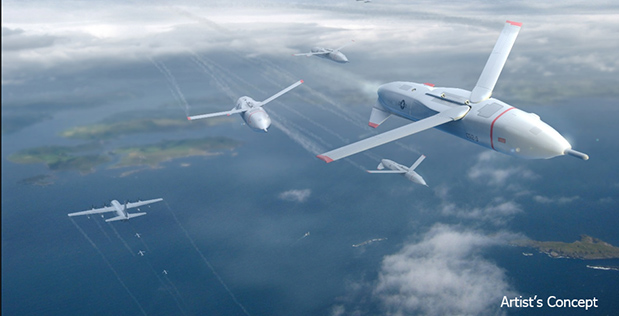DARPA ha lanzado el programa “Gremlins”, llamado así por los diablillos imaginarios y traviesos que se convirtieron en los amuletos de la buena suerte de muchos pilotos británicos durante la Segunda Guerra Mundial. El programa prevé el lanzamiento y recuperación de grupos de UAS desde grandes aviones en servicio, tales como bombarderos o aeronaves de transporte, así como desde cazas y otras plataformas de ala fija, permitiendo que los enjambres de UAS /UCAS completen la misión asignada, mientras que los aviones “nodriza” están fuera del alcance de las defensas adversarias. Cuando los “Gremlins” completan su misión, un avión de transporte C-130 los recogería en el aire y los llevaría de regreso a su base, donde el personal de tierra los prepararía para su próximo uso en 24 horas.
For decades, U.S. military air operations have relied on increasingly capable multi-function manned aircraft to execute critical combat and non-combat missions. Adversaries’ abilities to detect and engage those aircraft from longer ranges have improved over time as well, however, driving up the costs for vehicle design, operation and replacement. An ability to send large numbers of small unmanned air systems (UASs) with coordinated, distributed capabilities could provide U.S. forces with improved operational flexibility at much lower cost than is possible with today’s expensive, all-in-one platforms—especially if those unmanned systems could be retrieved for reuse while airborne. So far, however, the technology to project volleys of low-cost, reusable systems over great distances and retrieve them in mid-air has remained out of reach.
To help make that technology a reality, DARPA has launched the Gremlins program. Named for the imaginary, mischievous imps that became the good luck charms of many British pilots during World War II, the program envisions launching groups of UASs from existing large aircraft such as bombers or transport aircraft—as well as from fighters and other small, fixed-wing platforms—while those planes are out of range of adversary defenses. When the gremlins complete their mission, a C-130 transport aircraft would retrieve them in the air and carry them home, where ground crews would prepare them for their next use within 24 hours.
The gremlins’ expected lifetime of about 20 uses could provide significant cost advantages over expendable systems by reducing payload and airframe costs and by having lower mission and maintenance costs than conventional platforms, which are designed to operate for decades.
The Gremlins program plans to explore numerous technical areas, including:
- Launch and recovery techniques, equipment and aircraft integration concepts
- Low-cost, limited-life airframe designs
- High-fidelity analysis, precision digital flight control, relative navigation and station keeping
The program aims to conduct a compelling proof-of-concept flight demonstration that could employ intelligence, surveillance, and reconnaissance (ISR) and other modular, non-kinetic payloads in a robust, responsive, and affordable manner.
Fuente: https://www.darpa.mil


